Unit 187: Review and Critique of Operations Management at Tesco
VerifiedAdded on 2023/06/04
|19
|5476
|290
Report
AI Summary
This report provides a comprehensive review and critique of the operations management practices at Tesco, a multinational grocery and merchandise retailer. It begins with an introduction to Tesco and defines the key differences between 'operations' and 'operations management.' The report then critically examines the implementation of operations management principles within Tesco, analyzing how the company converts inputs into outputs and maintains a competitive edge. It evaluates the extent to which Tesco's operations management meets organizational requirements, focusing on its hierarchical structure, customer satisfaction strategies, and technology adoption. The report further explores continuous improvement as a philosophy, detailing Lean principles and models such as Six Sigma and Kaizen, and their applications within Tesco. It concludes with a detailed continuous improvement plan, offering justified recommendations based on the review of operations management principles and various theories like Taylor's Scientific Management, Kaizen, Six Sigma, and benchmarking, to enhance Tesco's operational efficiency and customer satisfaction.
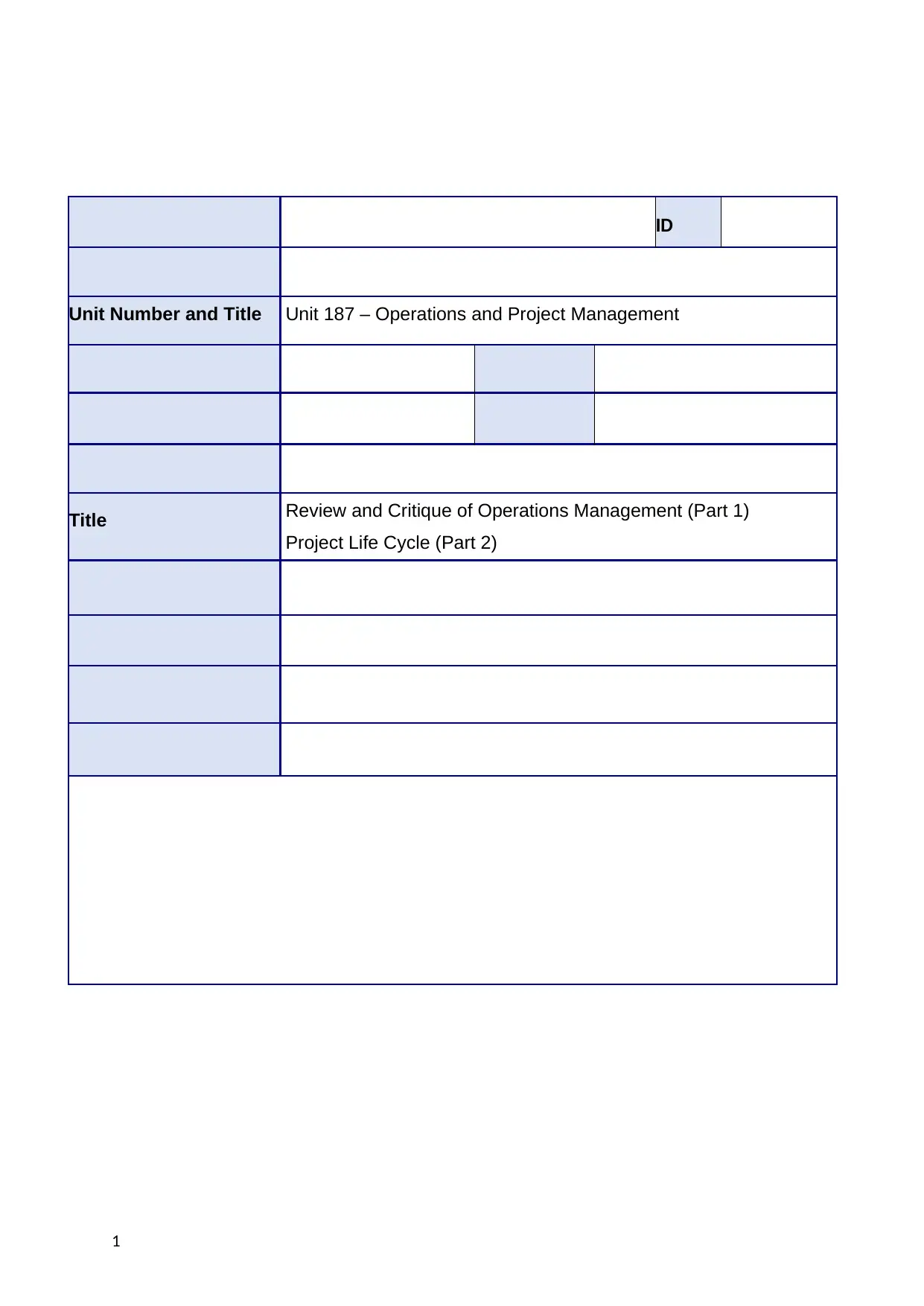
ID
Unit Number and Title Unit 187 – Operations and Project Management
Title Review and Critique of Operations Management (Part 1)
Project Life Cycle (Part 2)
1
Unit Number and Title Unit 187 – Operations and Project Management
Title Review and Critique of Operations Management (Part 1)
Project Life Cycle (Part 2)
1
Paraphrase This Document
Need a fresh take? Get an instant paraphrase of this document with our AI Paraphraser
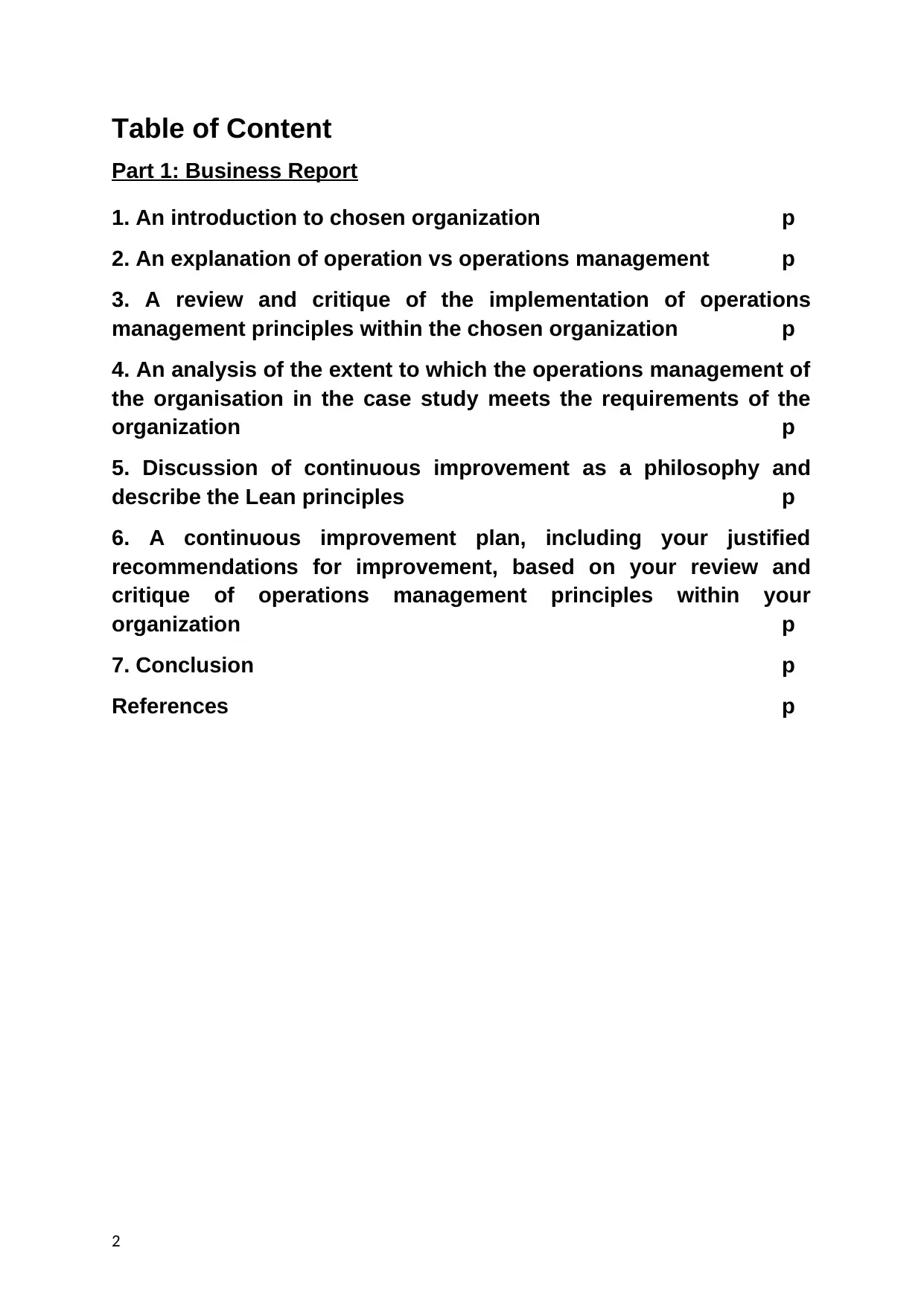
Table of Content
Part 1: Business Report
1. An introduction to chosen organization p
2. An explanation of operation vs operations management p
3. A review and critique of the implementation of operations
management principles within the chosen organization p
4. An analysis of the extent to which the operations management of
the organisation in the case study meets the requirements of the
organization p
5. Discussion of continuous improvement as a philosophy and
describe the Lean principles p
6. A continuous improvement plan, including your justified
recommendations for improvement, based on your review and
critique of operations management principles within your
organization p
7. Conclusion p
References p
2
Part 1: Business Report
1. An introduction to chosen organization p
2. An explanation of operation vs operations management p
3. A review and critique of the implementation of operations
management principles within the chosen organization p
4. An analysis of the extent to which the operations management of
the organisation in the case study meets the requirements of the
organization p
5. Discussion of continuous improvement as a philosophy and
describe the Lean principles p
6. A continuous improvement plan, including your justified
recommendations for improvement, based on your review and
critique of operations management principles within your
organization p
7. Conclusion p
References p
2
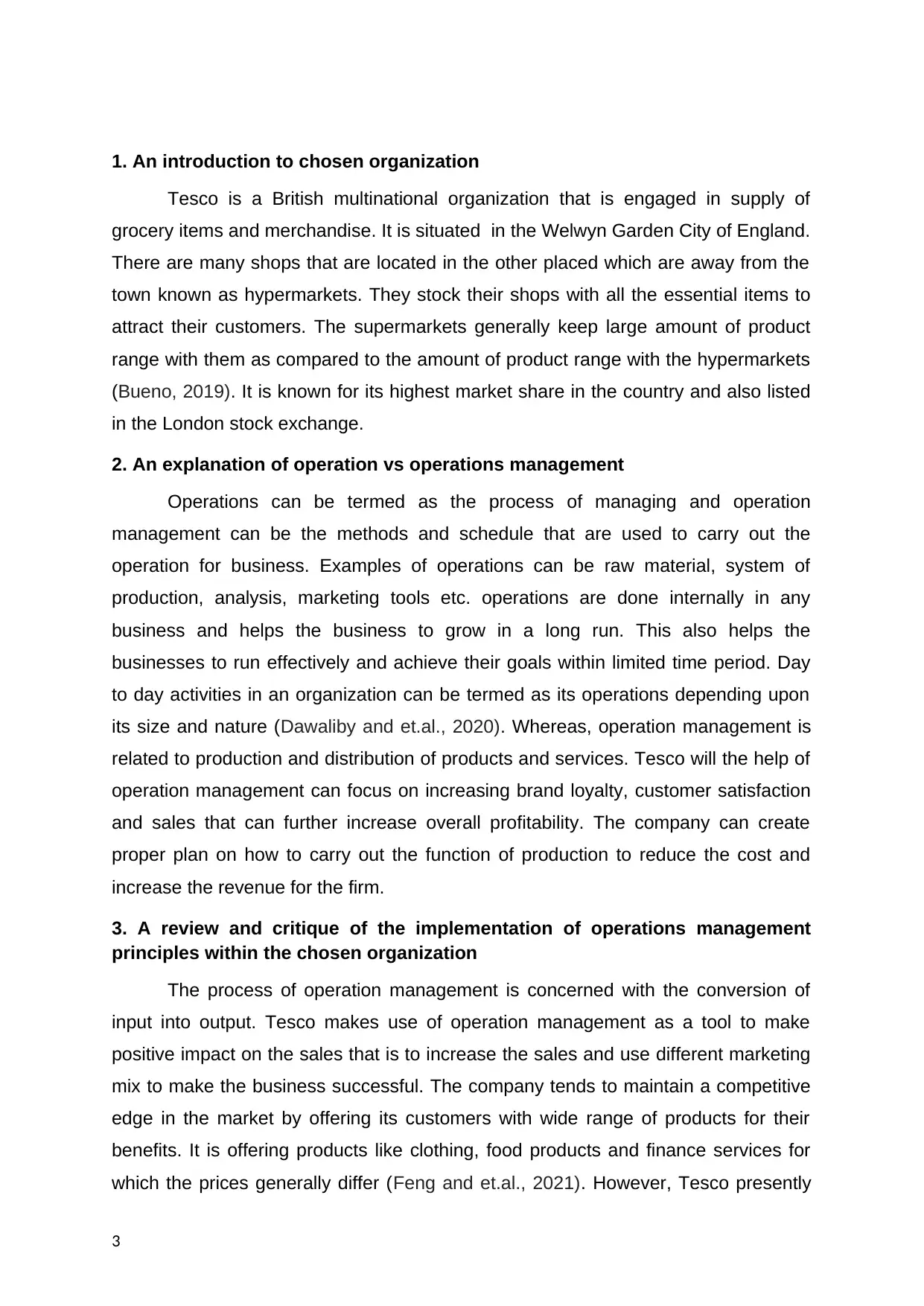
1. An introduction to chosen organization
Tesco is a British multinational organization that is engaged in supply of
grocery items and merchandise. It is situated in the Welwyn Garden City of England.
There are many shops that are located in the other placed which are away from the
town known as hypermarkets. They stock their shops with all the essential items to
attract their customers. The supermarkets generally keep large amount of product
range with them as compared to the amount of product range with the hypermarkets
(Bueno, 2019). It is known for its highest market share in the country and also listed
in the London stock exchange.
2. An explanation of operation vs operations management
Operations can be termed as the process of managing and operation
management can be the methods and schedule that are used to carry out the
operation for business. Examples of operations can be raw material, system of
production, analysis, marketing tools etc. operations are done internally in any
business and helps the business to grow in a long run. This also helps the
businesses to run effectively and achieve their goals within limited time period. Day
to day activities in an organization can be termed as its operations depending upon
its size and nature (Dawaliby and et.al., 2020). Whereas, operation management is
related to production and distribution of products and services. Tesco will the help of
operation management can focus on increasing brand loyalty, customer satisfaction
and sales that can further increase overall profitability. The company can create
proper plan on how to carry out the function of production to reduce the cost and
increase the revenue for the firm.
3. A review and critique of the implementation of operations management
principles within the chosen organization
The process of operation management is concerned with the conversion of
input into output. Tesco makes use of operation management as a tool to make
positive impact on the sales that is to increase the sales and use different marketing
mix to make the business successful. The company tends to maintain a competitive
edge in the market by offering its customers with wide range of products for their
benefits. It is offering products like clothing, food products and finance services for
which the prices generally differ (Feng and et.al., 2021). However, Tesco presently
3
Tesco is a British multinational organization that is engaged in supply of
grocery items and merchandise. It is situated in the Welwyn Garden City of England.
There are many shops that are located in the other placed which are away from the
town known as hypermarkets. They stock their shops with all the essential items to
attract their customers. The supermarkets generally keep large amount of product
range with them as compared to the amount of product range with the hypermarkets
(Bueno, 2019). It is known for its highest market share in the country and also listed
in the London stock exchange.
2. An explanation of operation vs operations management
Operations can be termed as the process of managing and operation
management can be the methods and schedule that are used to carry out the
operation for business. Examples of operations can be raw material, system of
production, analysis, marketing tools etc. operations are done internally in any
business and helps the business to grow in a long run. This also helps the
businesses to run effectively and achieve their goals within limited time period. Day
to day activities in an organization can be termed as its operations depending upon
its size and nature (Dawaliby and et.al., 2020). Whereas, operation management is
related to production and distribution of products and services. Tesco will the help of
operation management can focus on increasing brand loyalty, customer satisfaction
and sales that can further increase overall profitability. The company can create
proper plan on how to carry out the function of production to reduce the cost and
increase the revenue for the firm.
3. A review and critique of the implementation of operations management
principles within the chosen organization
The process of operation management is concerned with the conversion of
input into output. Tesco makes use of operation management as a tool to make
positive impact on the sales that is to increase the sales and use different marketing
mix to make the business successful. The company tends to maintain a competitive
edge in the market by offering its customers with wide range of products for their
benefits. It is offering products like clothing, food products and finance services for
which the prices generally differ (Feng and et.al., 2021). However, Tesco presently
3
⊘ This is a preview!⊘
Do you want full access?
Subscribe today to unlock all pages.

Trusted by 1+ million students worldwide
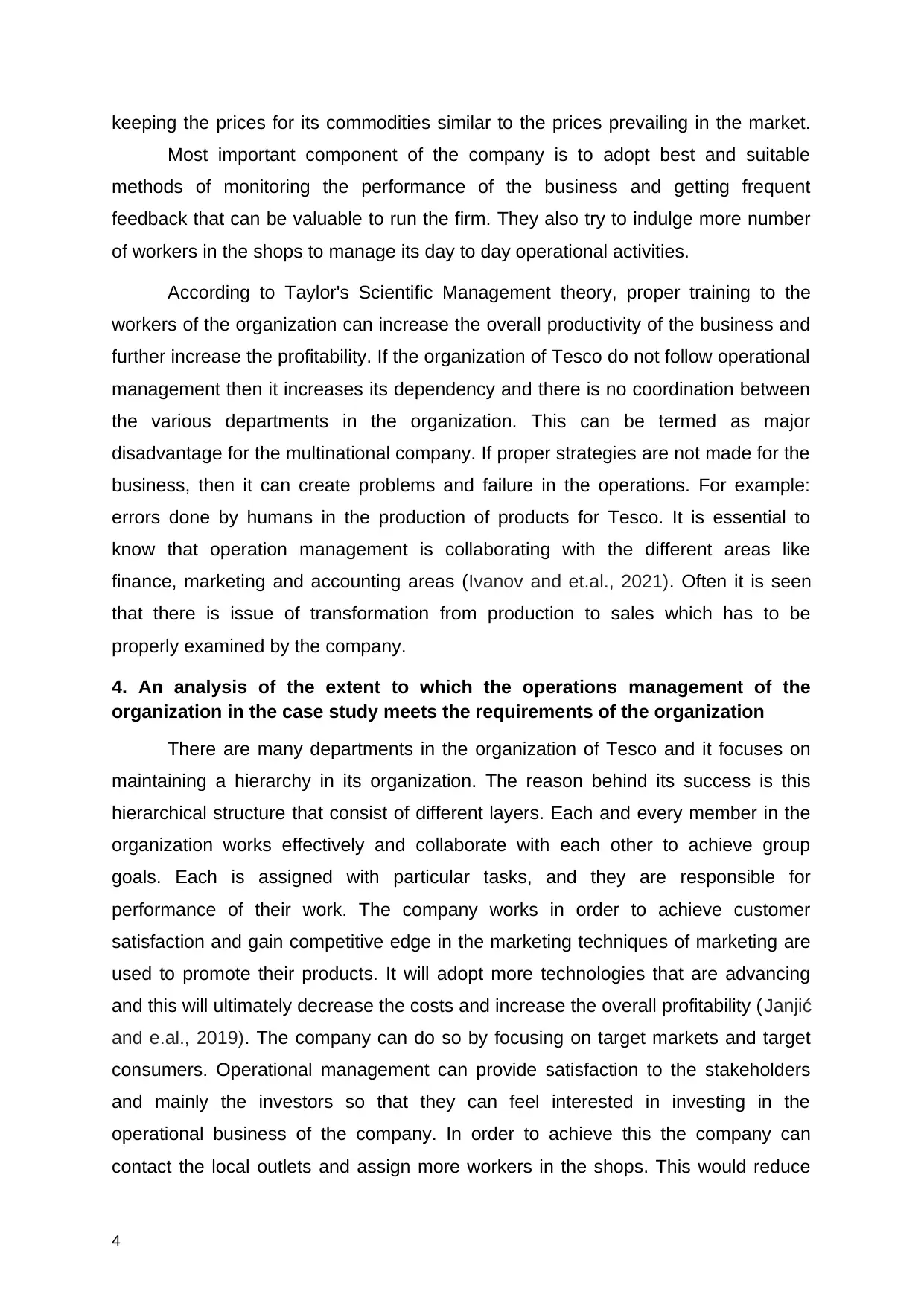
keeping the prices for its commodities similar to the prices prevailing in the market.
Most important component of the company is to adopt best and suitable
methods of monitoring the performance of the business and getting frequent
feedback that can be valuable to run the firm. They also try to indulge more number
of workers in the shops to manage its day to day operational activities.
According to Taylor's Scientific Management theory, proper training to the
workers of the organization can increase the overall productivity of the business and
further increase the profitability. If the organization of Tesco do not follow operational
management then it increases its dependency and there is no coordination between
the various departments in the organization. This can be termed as major
disadvantage for the multinational company. If proper strategies are not made for the
business, then it can create problems and failure in the operations. For example:
errors done by humans in the production of products for Tesco. It is essential to
know that operation management is collaborating with the different areas like
finance, marketing and accounting areas (Ivanov and et.al., 2021). Often it is seen
that there is issue of transformation from production to sales which has to be
properly examined by the company.
4. An analysis of the extent to which the operations management of the
organization in the case study meets the requirements of the organization
There are many departments in the organization of Tesco and it focuses on
maintaining a hierarchy in its organization. The reason behind its success is this
hierarchical structure that consist of different layers. Each and every member in the
organization works effectively and collaborate with each other to achieve group
goals. Each is assigned with particular tasks, and they are responsible for
performance of their work. The company works in order to achieve customer
satisfaction and gain competitive edge in the marketing techniques of marketing are
used to promote their products. It will adopt more technologies that are advancing
and this will ultimately decrease the costs and increase the overall profitability ( Janjić
and e.al., 2019). The company can do so by focusing on target markets and target
consumers. Operational management can provide satisfaction to the stakeholders
and mainly the investors so that they can feel interested in investing in the
operational business of the company. In order to achieve this the company can
contact the local outlets and assign more workers in the shops. This would reduce
4
Most important component of the company is to adopt best and suitable
methods of monitoring the performance of the business and getting frequent
feedback that can be valuable to run the firm. They also try to indulge more number
of workers in the shops to manage its day to day operational activities.
According to Taylor's Scientific Management theory, proper training to the
workers of the organization can increase the overall productivity of the business and
further increase the profitability. If the organization of Tesco do not follow operational
management then it increases its dependency and there is no coordination between
the various departments in the organization. This can be termed as major
disadvantage for the multinational company. If proper strategies are not made for the
business, then it can create problems and failure in the operations. For example:
errors done by humans in the production of products for Tesco. It is essential to
know that operation management is collaborating with the different areas like
finance, marketing and accounting areas (Ivanov and et.al., 2021). Often it is seen
that there is issue of transformation from production to sales which has to be
properly examined by the company.
4. An analysis of the extent to which the operations management of the
organization in the case study meets the requirements of the organization
There are many departments in the organization of Tesco and it focuses on
maintaining a hierarchy in its organization. The reason behind its success is this
hierarchical structure that consist of different layers. Each and every member in the
organization works effectively and collaborate with each other to achieve group
goals. Each is assigned with particular tasks, and they are responsible for
performance of their work. The company works in order to achieve customer
satisfaction and gain competitive edge in the marketing techniques of marketing are
used to promote their products. It will adopt more technologies that are advancing
and this will ultimately decrease the costs and increase the overall profitability ( Janjić
and e.al., 2019). The company can do so by focusing on target markets and target
consumers. Operational management can provide satisfaction to the stakeholders
and mainly the investors so that they can feel interested in investing in the
operational business of the company. In order to achieve this the company can
contact the local outlets and assign more workers in the shops. This would reduce
4
Paraphrase This Document
Need a fresh take? Get an instant paraphrase of this document with our AI Paraphraser
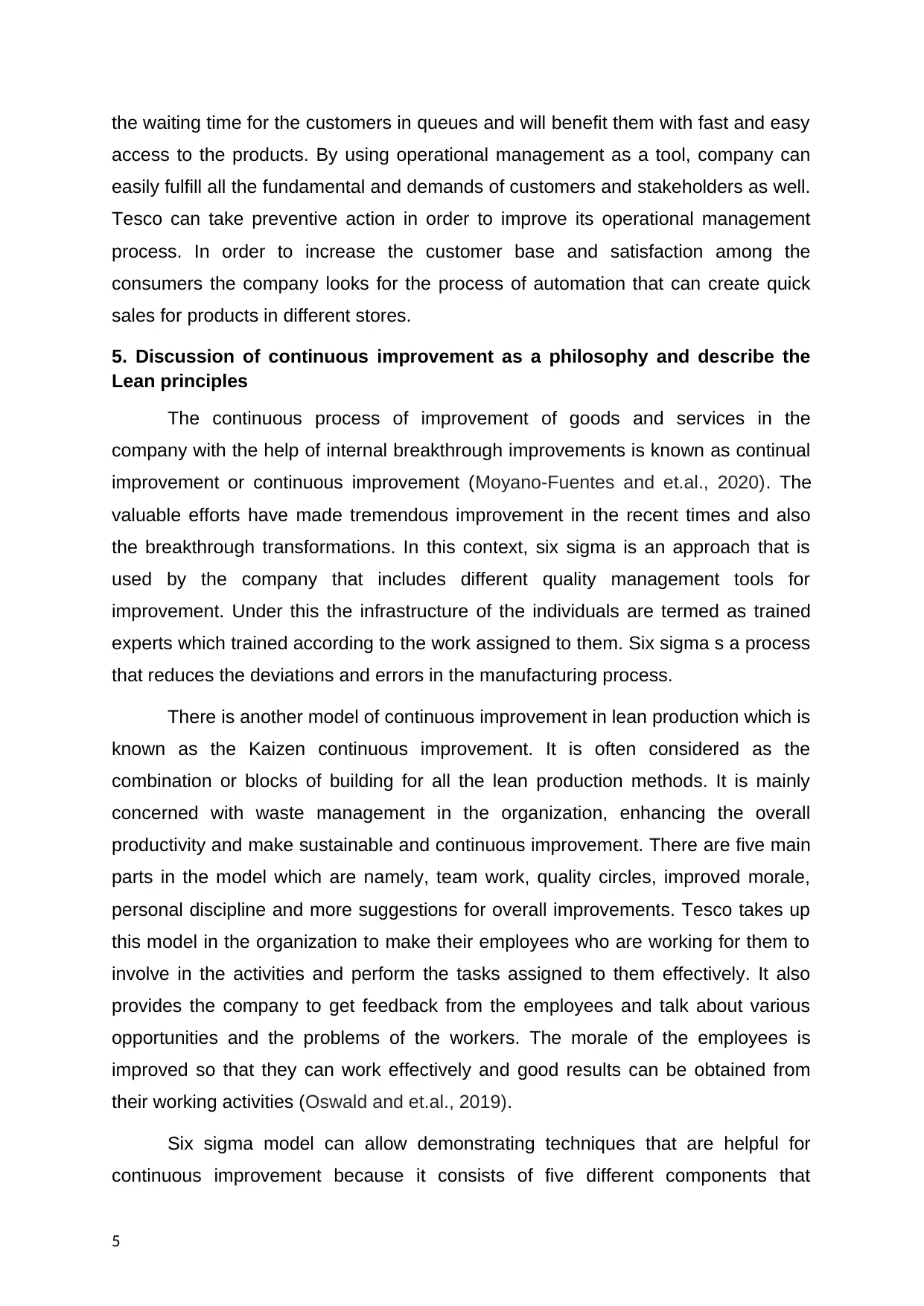
the waiting time for the customers in queues and will benefit them with fast and easy
access to the products. By using operational management as a tool, company can
easily fulfill all the fundamental and demands of customers and stakeholders as well.
Tesco can take preventive action in order to improve its operational management
process. In order to increase the customer base and satisfaction among the
consumers the company looks for the process of automation that can create quick
sales for products in different stores.
5. Discussion of continuous improvement as a philosophy and describe the
Lean principles
The continuous process of improvement of goods and services in the
company with the help of internal breakthrough improvements is known as continual
improvement or continuous improvement (Moyano-Fuentes and et.al., 2020). The
valuable efforts have made tremendous improvement in the recent times and also
the breakthrough transformations. In this context, six sigma is an approach that is
used by the company that includes different quality management tools for
improvement. Under this the infrastructure of the individuals are termed as trained
experts which trained according to the work assigned to them. Six sigma s a process
that reduces the deviations and errors in the manufacturing process.
There is another model of continuous improvement in lean production which is
known as the Kaizen continuous improvement. It is often considered as the
combination or blocks of building for all the lean production methods. It is mainly
concerned with waste management in the organization, enhancing the overall
productivity and make sustainable and continuous improvement. There are five main
parts in the model which are namely, team work, quality circles, improved morale,
personal discipline and more suggestions for overall improvements. Tesco takes up
this model in the organization to make their employees who are working for them to
involve in the activities and perform the tasks assigned to them effectively. It also
provides the company to get feedback from the employees and talk about various
opportunities and the problems of the workers. The morale of the employees is
improved so that they can work effectively and good results can be obtained from
their working activities (Oswald and et.al., 2019).
Six sigma model can allow demonstrating techniques that are helpful for
continuous improvement because it consists of five different components that
5
access to the products. By using operational management as a tool, company can
easily fulfill all the fundamental and demands of customers and stakeholders as well.
Tesco can take preventive action in order to improve its operational management
process. In order to increase the customer base and satisfaction among the
consumers the company looks for the process of automation that can create quick
sales for products in different stores.
5. Discussion of continuous improvement as a philosophy and describe the
Lean principles
The continuous process of improvement of goods and services in the
company with the help of internal breakthrough improvements is known as continual
improvement or continuous improvement (Moyano-Fuentes and et.al., 2020). The
valuable efforts have made tremendous improvement in the recent times and also
the breakthrough transformations. In this context, six sigma is an approach that is
used by the company that includes different quality management tools for
improvement. Under this the infrastructure of the individuals are termed as trained
experts which trained according to the work assigned to them. Six sigma s a process
that reduces the deviations and errors in the manufacturing process.
There is another model of continuous improvement in lean production which is
known as the Kaizen continuous improvement. It is often considered as the
combination or blocks of building for all the lean production methods. It is mainly
concerned with waste management in the organization, enhancing the overall
productivity and make sustainable and continuous improvement. There are five main
parts in the model which are namely, team work, quality circles, improved morale,
personal discipline and more suggestions for overall improvements. Tesco takes up
this model in the organization to make their employees who are working for them to
involve in the activities and perform the tasks assigned to them effectively. It also
provides the company to get feedback from the employees and talk about various
opportunities and the problems of the workers. The morale of the employees is
improved so that they can work effectively and good results can be obtained from
their working activities (Oswald and et.al., 2019).
Six sigma model can allow demonstrating techniques that are helpful for
continuous improvement because it consists of five different components that
5
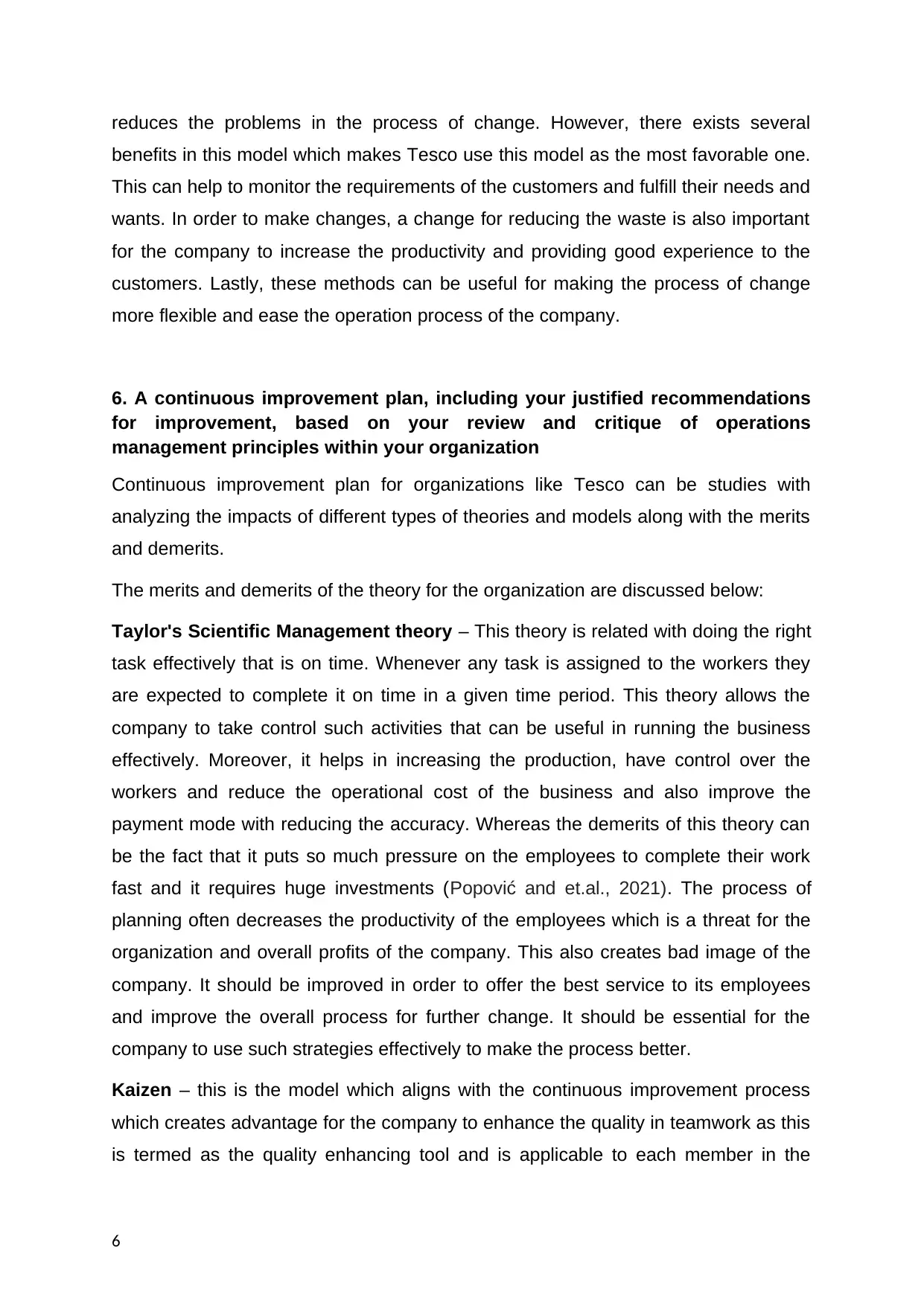
reduces the problems in the process of change. However, there exists several
benefits in this model which makes Tesco use this model as the most favorable one.
This can help to monitor the requirements of the customers and fulfill their needs and
wants. In order to make changes, a change for reducing the waste is also important
for the company to increase the productivity and providing good experience to the
customers. Lastly, these methods can be useful for making the process of change
more flexible and ease the operation process of the company.
6. A continuous improvement plan, including your justified recommendations
for improvement, based on your review and critique of operations
management principles within your organization
Continuous improvement plan for organizations like Tesco can be studies with
analyzing the impacts of different types of theories and models along with the merits
and demerits.
The merits and demerits of the theory for the organization are discussed below:
Taylor's Scientific Management theory – This theory is related with doing the right
task effectively that is on time. Whenever any task is assigned to the workers they
are expected to complete it on time in a given time period. This theory allows the
company to take control such activities that can be useful in running the business
effectively. Moreover, it helps in increasing the production, have control over the
workers and reduce the operational cost of the business and also improve the
payment mode with reducing the accuracy. Whereas the demerits of this theory can
be the fact that it puts so much pressure on the employees to complete their work
fast and it requires huge investments (Popović and et.al., 2021). The process of
planning often decreases the productivity of the employees which is a threat for the
organization and overall profits of the company. This also creates bad image of the
company. It should be improved in order to offer the best service to its employees
and improve the overall process for further change. It should be essential for the
company to use such strategies effectively to make the process better.
Kaizen – this is the model which aligns with the continuous improvement process
which creates advantage for the company to enhance the quality in teamwork as this
is termed as the quality enhancing tool and is applicable to each member in the
6
benefits in this model which makes Tesco use this model as the most favorable one.
This can help to monitor the requirements of the customers and fulfill their needs and
wants. In order to make changes, a change for reducing the waste is also important
for the company to increase the productivity and providing good experience to the
customers. Lastly, these methods can be useful for making the process of change
more flexible and ease the operation process of the company.
6. A continuous improvement plan, including your justified recommendations
for improvement, based on your review and critique of operations
management principles within your organization
Continuous improvement plan for organizations like Tesco can be studies with
analyzing the impacts of different types of theories and models along with the merits
and demerits.
The merits and demerits of the theory for the organization are discussed below:
Taylor's Scientific Management theory – This theory is related with doing the right
task effectively that is on time. Whenever any task is assigned to the workers they
are expected to complete it on time in a given time period. This theory allows the
company to take control such activities that can be useful in running the business
effectively. Moreover, it helps in increasing the production, have control over the
workers and reduce the operational cost of the business and also improve the
payment mode with reducing the accuracy. Whereas the demerits of this theory can
be the fact that it puts so much pressure on the employees to complete their work
fast and it requires huge investments (Popović and et.al., 2021). The process of
planning often decreases the productivity of the employees which is a threat for the
organization and overall profits of the company. This also creates bad image of the
company. It should be improved in order to offer the best service to its employees
and improve the overall process for further change. It should be essential for the
company to use such strategies effectively to make the process better.
Kaizen – this is the model which aligns with the continuous improvement process
which creates advantage for the company to enhance the quality in teamwork as this
is termed as the quality enhancing tool and is applicable to each member in the
6
⊘ This is a preview!⊘
Do you want full access?
Subscribe today to unlock all pages.

Trusted by 1+ million students worldwide
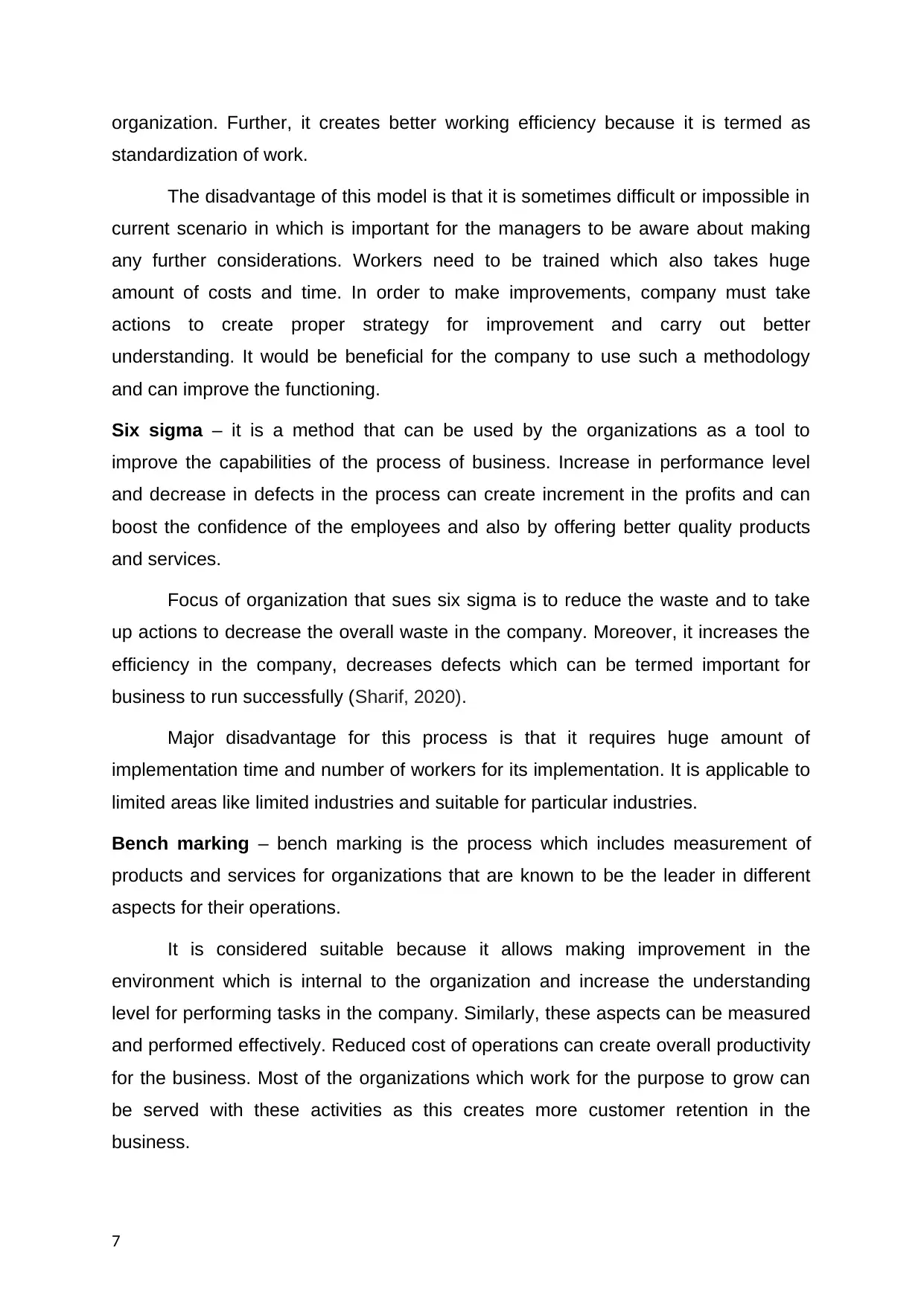
organization. Further, it creates better working efficiency because it is termed as
standardization of work.
The disadvantage of this model is that it is sometimes difficult or impossible in
current scenario in which is important for the managers to be aware about making
any further considerations. Workers need to be trained which also takes huge
amount of costs and time. In order to make improvements, company must take
actions to create proper strategy for improvement and carry out better
understanding. It would be beneficial for the company to use such a methodology
and can improve the functioning.
Six sigma – it is a method that can be used by the organizations as a tool to
improve the capabilities of the process of business. Increase in performance level
and decrease in defects in the process can create increment in the profits and can
boost the confidence of the employees and also by offering better quality products
and services.
Focus of organization that sues six sigma is to reduce the waste and to take
up actions to decrease the overall waste in the company. Moreover, it increases the
efficiency in the company, decreases defects which can be termed important for
business to run successfully (Sharif, 2020).
Major disadvantage for this process is that it requires huge amount of
implementation time and number of workers for its implementation. It is applicable to
limited areas like limited industries and suitable for particular industries.
Bench marking – bench marking is the process which includes measurement of
products and services for organizations that are known to be the leader in different
aspects for their operations.
It is considered suitable because it allows making improvement in the
environment which is internal to the organization and increase the understanding
level for performing tasks in the company. Similarly, these aspects can be measured
and performed effectively. Reduced cost of operations can create overall productivity
for the business. Most of the organizations which work for the purpose to grow can
be served with these activities as this creates more customer retention in the
business.
7
standardization of work.
The disadvantage of this model is that it is sometimes difficult or impossible in
current scenario in which is important for the managers to be aware about making
any further considerations. Workers need to be trained which also takes huge
amount of costs and time. In order to make improvements, company must take
actions to create proper strategy for improvement and carry out better
understanding. It would be beneficial for the company to use such a methodology
and can improve the functioning.
Six sigma – it is a method that can be used by the organizations as a tool to
improve the capabilities of the process of business. Increase in performance level
and decrease in defects in the process can create increment in the profits and can
boost the confidence of the employees and also by offering better quality products
and services.
Focus of organization that sues six sigma is to reduce the waste and to take
up actions to decrease the overall waste in the company. Moreover, it increases the
efficiency in the company, decreases defects which can be termed important for
business to run successfully (Sharif, 2020).
Major disadvantage for this process is that it requires huge amount of
implementation time and number of workers for its implementation. It is applicable to
limited areas like limited industries and suitable for particular industries.
Bench marking – bench marking is the process which includes measurement of
products and services for organizations that are known to be the leader in different
aspects for their operations.
It is considered suitable because it allows making improvement in the
environment which is internal to the organization and increase the understanding
level for performing tasks in the company. Similarly, these aspects can be measured
and performed effectively. Reduced cost of operations can create overall productivity
for the business. Most of the organizations which work for the purpose to grow can
be served with these activities as this creates more customer retention in the
business.
7
Paraphrase This Document
Need a fresh take? Get an instant paraphrase of this document with our AI Paraphraser
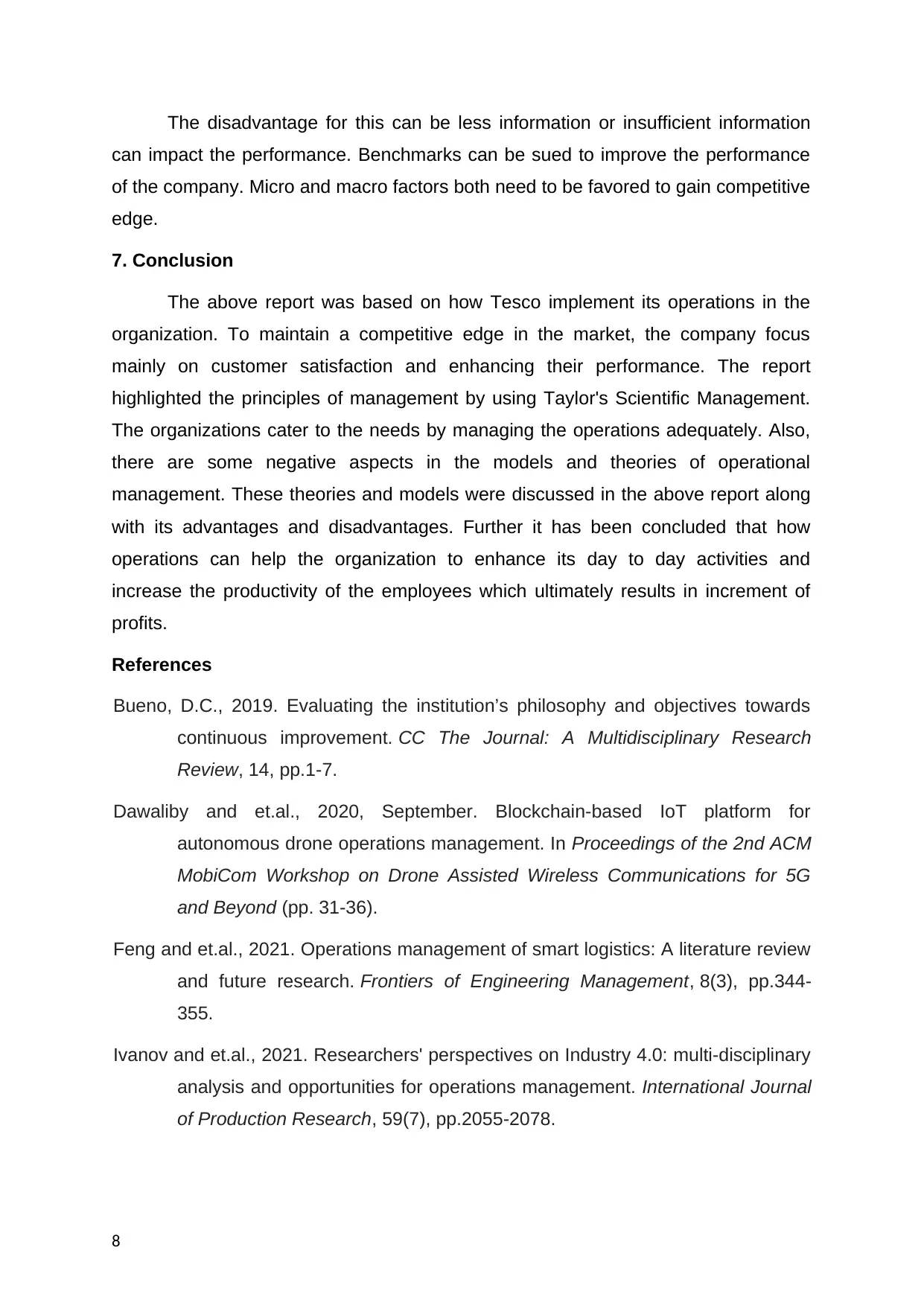
The disadvantage for this can be less information or insufficient information
can impact the performance. Benchmarks can be sued to improve the performance
of the company. Micro and macro factors both need to be favored to gain competitive
edge.
7. Conclusion
The above report was based on how Tesco implement its operations in the
organization. To maintain a competitive edge in the market, the company focus
mainly on customer satisfaction and enhancing their performance. The report
highlighted the principles of management by using Taylor's Scientific Management.
The organizations cater to the needs by managing the operations adequately. Also,
there are some negative aspects in the models and theories of operational
management. These theories and models were discussed in the above report along
with its advantages and disadvantages. Further it has been concluded that how
operations can help the organization to enhance its day to day activities and
increase the productivity of the employees which ultimately results in increment of
profits.
References
Bueno, D.C., 2019. Evaluating the institution’s philosophy and objectives towards
continuous improvement. CC The Journal: A Multidisciplinary Research
Review, 14, pp.1-7.
Dawaliby and et.al., 2020, September. Blockchain-based IoT platform for
autonomous drone operations management. In Proceedings of the 2nd ACM
MobiCom Workshop on Drone Assisted Wireless Communications for 5G
and Beyond (pp. 31-36).
Feng and et.al., 2021. Operations management of smart logistics: A literature review
and future research. Frontiers of Engineering Management, 8(3), pp.344-
355.
Ivanov and et.al., 2021. Researchers' perspectives on Industry 4.0: multi-disciplinary
analysis and opportunities for operations management. International Journal
of Production Research, 59(7), pp.2055-2078.
8
can impact the performance. Benchmarks can be sued to improve the performance
of the company. Micro and macro factors both need to be favored to gain competitive
edge.
7. Conclusion
The above report was based on how Tesco implement its operations in the
organization. To maintain a competitive edge in the market, the company focus
mainly on customer satisfaction and enhancing their performance. The report
highlighted the principles of management by using Taylor's Scientific Management.
The organizations cater to the needs by managing the operations adequately. Also,
there are some negative aspects in the models and theories of operational
management. These theories and models were discussed in the above report along
with its advantages and disadvantages. Further it has been concluded that how
operations can help the organization to enhance its day to day activities and
increase the productivity of the employees which ultimately results in increment of
profits.
References
Bueno, D.C., 2019. Evaluating the institution’s philosophy and objectives towards
continuous improvement. CC The Journal: A Multidisciplinary Research
Review, 14, pp.1-7.
Dawaliby and et.al., 2020, September. Blockchain-based IoT platform for
autonomous drone operations management. In Proceedings of the 2nd ACM
MobiCom Workshop on Drone Assisted Wireless Communications for 5G
and Beyond (pp. 31-36).
Feng and et.al., 2021. Operations management of smart logistics: A literature review
and future research. Frontiers of Engineering Management, 8(3), pp.344-
355.
Ivanov and et.al., 2021. Researchers' perspectives on Industry 4.0: multi-disciplinary
analysis and opportunities for operations management. International Journal
of Production Research, 59(7), pp.2055-2078.
8
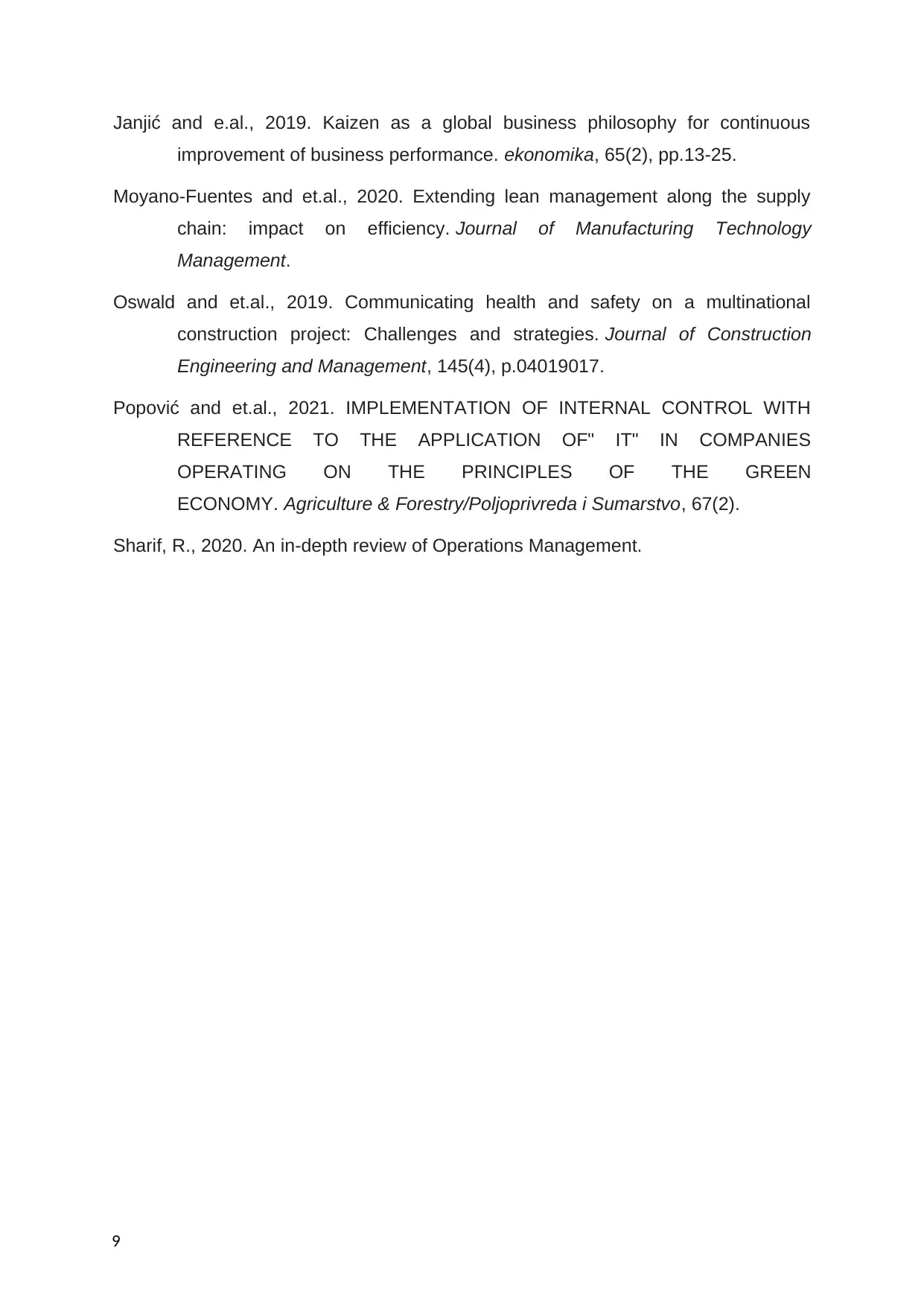
Janjić and e.al., 2019. Kaizen as a global business philosophy for continuous
improvement of business performance. ekonomika, 65(2), pp.13-25.
Moyano-Fuentes and et.al., 2020. Extending lean management along the supply
chain: impact on efficiency. Journal of Manufacturing Technology
Management.
Oswald and et.al., 2019. Communicating health and safety on a multinational
construction project: Challenges and strategies. Journal of Construction
Engineering and Management, 145(4), p.04019017.
Popović and et.al., 2021. IMPLEMENTATION OF INTERNAL CONTROL WITH
REFERENCE TO THE APPLICATION OF" IT" IN COMPANIES
OPERATING ON THE PRINCIPLES OF THE GREEN
ECONOMY. Agriculture & Forestry/Poljoprivreda i Sumarstvo, 67(2).
Sharif, R., 2020. An in-depth review of Operations Management.
9
improvement of business performance. ekonomika, 65(2), pp.13-25.
Moyano-Fuentes and et.al., 2020. Extending lean management along the supply
chain: impact on efficiency. Journal of Manufacturing Technology
Management.
Oswald and et.al., 2019. Communicating health and safety on a multinational
construction project: Challenges and strategies. Journal of Construction
Engineering and Management, 145(4), p.04019017.
Popović and et.al., 2021. IMPLEMENTATION OF INTERNAL CONTROL WITH
REFERENCE TO THE APPLICATION OF" IT" IN COMPANIES
OPERATING ON THE PRINCIPLES OF THE GREEN
ECONOMY. Agriculture & Forestry/Poljoprivreda i Sumarstvo, 67(2).
Sharif, R., 2020. An in-depth review of Operations Management.
9
⊘ This is a preview!⊘
Do you want full access?
Subscribe today to unlock all pages.

Trusted by 1+ million students worldwide
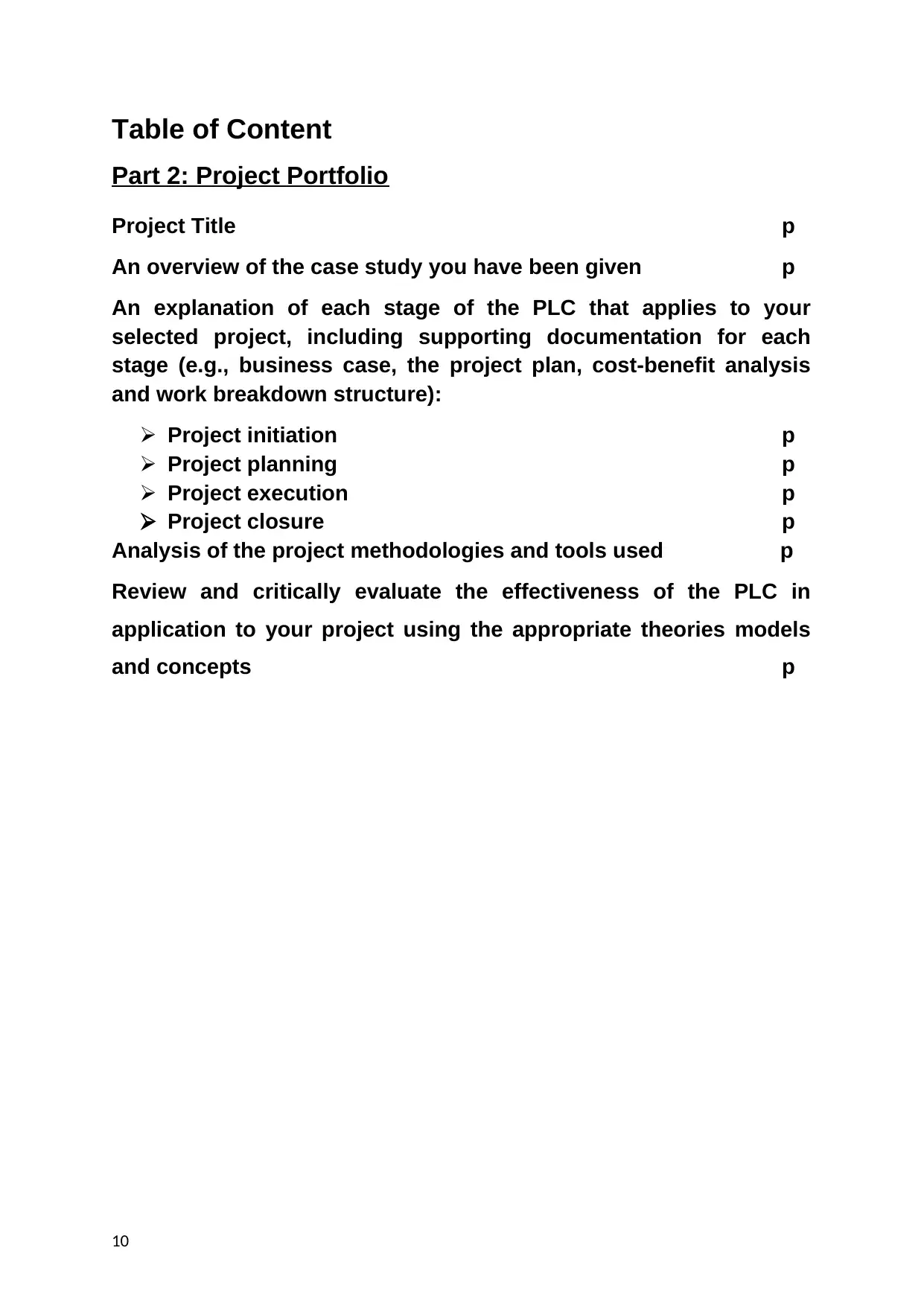
Table of Content
Part 2: Project Portfolio
Project Title p
An overview of the case study you have been given p
An explanation of each stage of the PLC that applies to your
selected project, including supporting documentation for each
stage (e.g., business case, the project plan, cost-benefit analysis
and work breakdown structure):
Project initiation p
Project planning p
Project execution p
Project closure p
Analysis of the project methodologies and tools used p
Review and critically evaluate the effectiveness of the PLC in
application to your project using the appropriate theories models
and concepts p
10
Part 2: Project Portfolio
Project Title p
An overview of the case study you have been given p
An explanation of each stage of the PLC that applies to your
selected project, including supporting documentation for each
stage (e.g., business case, the project plan, cost-benefit analysis
and work breakdown structure):
Project initiation p
Project planning p
Project execution p
Project closure p
Analysis of the project methodologies and tools used p
Review and critically evaluate the effectiveness of the PLC in
application to your project using the appropriate theories models
and concepts p
10
Paraphrase This Document
Need a fresh take? Get an instant paraphrase of this document with our AI Paraphraser
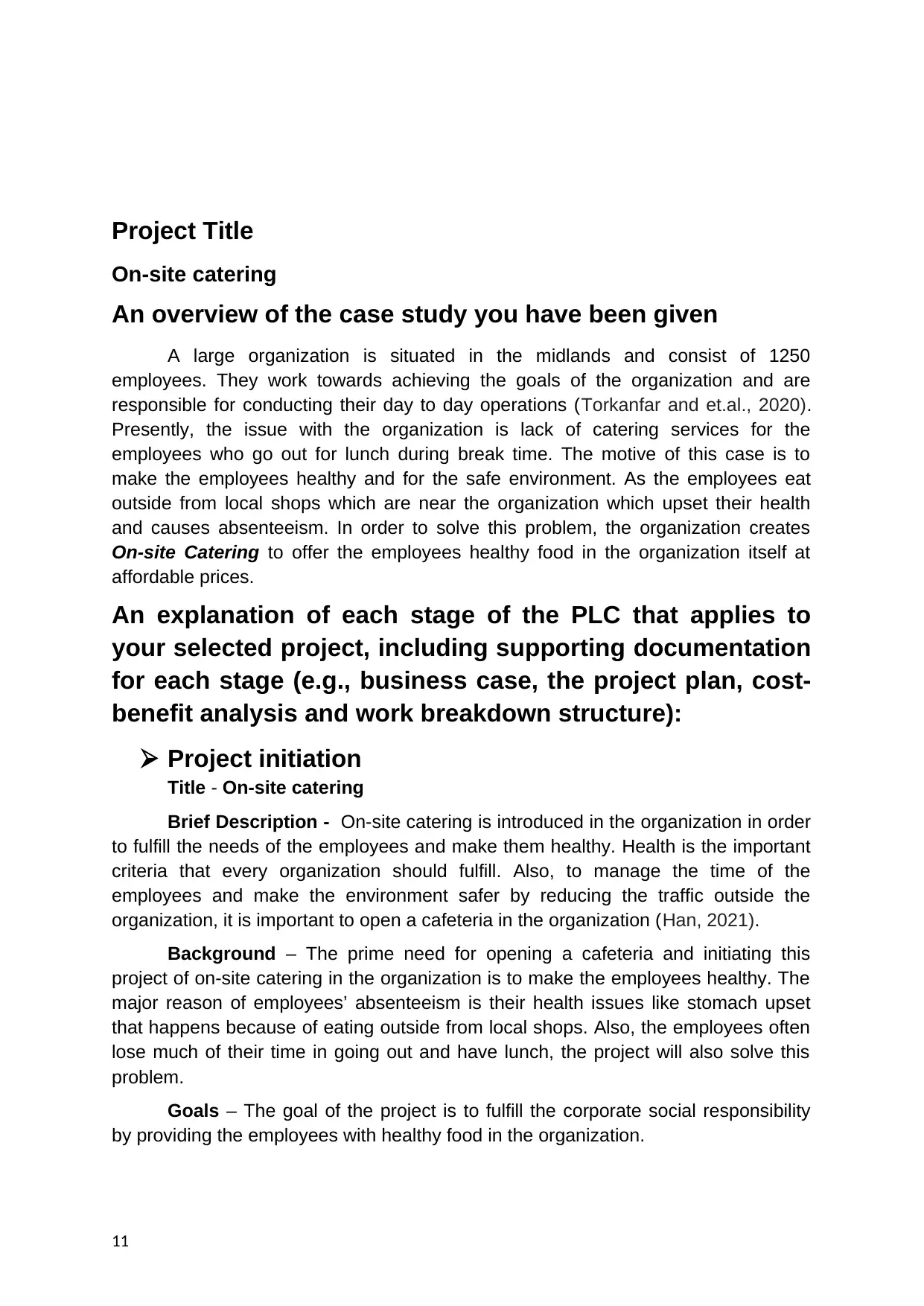
Project Title
On-site catering
An overview of the case study you have been given
A large organization is situated in the midlands and consist of 1250
employees. They work towards achieving the goals of the organization and are
responsible for conducting their day to day operations (Torkanfar and et.al., 2020).
Presently, the issue with the organization is lack of catering services for the
employees who go out for lunch during break time. The motive of this case is to
make the employees healthy and for the safe environment. As the employees eat
outside from local shops which are near the organization which upset their health
and causes absenteeism. In order to solve this problem, the organization creates
On-site Catering to offer the employees healthy food in the organization itself at
affordable prices.
An explanation of each stage of the PLC that applies to
your selected project, including supporting documentation
for each stage (e.g., business case, the project plan, cost-
benefit analysis and work breakdown structure):
Project initiation
Title - On-site catering
Brief Description - On-site catering is introduced in the organization in order
to fulfill the needs of the employees and make them healthy. Health is the important
criteria that every organization should fulfill. Also, to manage the time of the
employees and make the environment safer by reducing the traffic outside the
organization, it is important to open a cafeteria in the organization (Han, 2021).
Background – The prime need for opening a cafeteria and initiating this
project of on-site catering in the organization is to make the employees healthy. The
major reason of employees’ absenteeism is their health issues like stomach upset
that happens because of eating outside from local shops. Also, the employees often
lose much of their time in going out and have lunch, the project will also solve this
problem.
Goals – The goal of the project is to fulfill the corporate social responsibility
by providing the employees with healthy food in the organization.
11
On-site catering
An overview of the case study you have been given
A large organization is situated in the midlands and consist of 1250
employees. They work towards achieving the goals of the organization and are
responsible for conducting their day to day operations (Torkanfar and et.al., 2020).
Presently, the issue with the organization is lack of catering services for the
employees who go out for lunch during break time. The motive of this case is to
make the employees healthy and for the safe environment. As the employees eat
outside from local shops which are near the organization which upset their health
and causes absenteeism. In order to solve this problem, the organization creates
On-site Catering to offer the employees healthy food in the organization itself at
affordable prices.
An explanation of each stage of the PLC that applies to
your selected project, including supporting documentation
for each stage (e.g., business case, the project plan, cost-
benefit analysis and work breakdown structure):
Project initiation
Title - On-site catering
Brief Description - On-site catering is introduced in the organization in order
to fulfill the needs of the employees and make them healthy. Health is the important
criteria that every organization should fulfill. Also, to manage the time of the
employees and make the environment safer by reducing the traffic outside the
organization, it is important to open a cafeteria in the organization (Han, 2021).
Background – The prime need for opening a cafeteria and initiating this
project of on-site catering in the organization is to make the employees healthy. The
major reason of employees’ absenteeism is their health issues like stomach upset
that happens because of eating outside from local shops. Also, the employees often
lose much of their time in going out and have lunch, the project will also solve this
problem.
Goals – The goal of the project is to fulfill the corporate social responsibility
by providing the employees with healthy food in the organization.
11
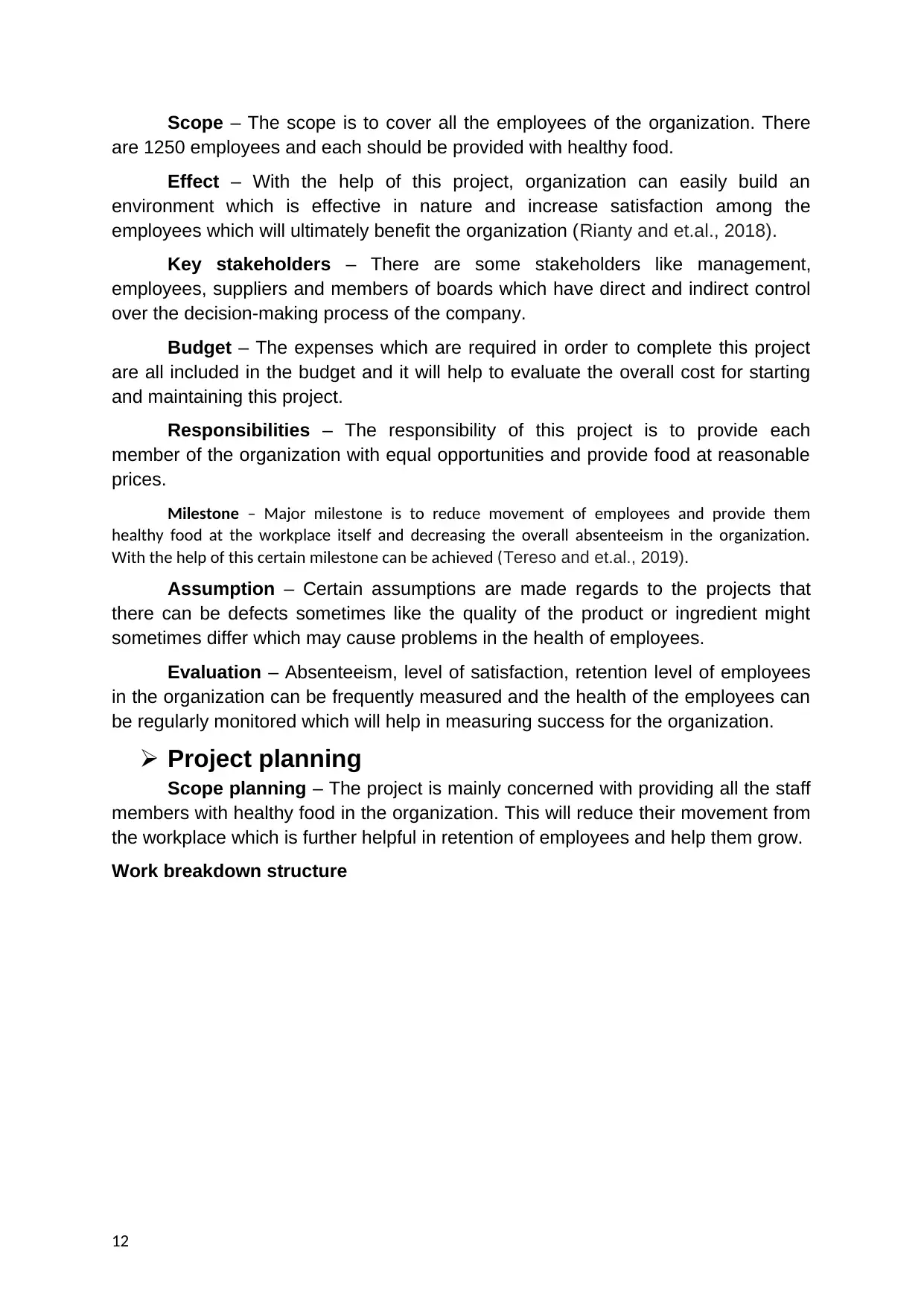
Scope – The scope is to cover all the employees of the organization. There
are 1250 employees and each should be provided with healthy food.
Effect – With the help of this project, organization can easily build an
environment which is effective in nature and increase satisfaction among the
employees which will ultimately benefit the organization (Rianty and et.al., 2018).
Key stakeholders – There are some stakeholders like management,
employees, suppliers and members of boards which have direct and indirect control
over the decision-making process of the company.
Budget – The expenses which are required in order to complete this project
are all included in the budget and it will help to evaluate the overall cost for starting
and maintaining this project.
Responsibilities – The responsibility of this project is to provide each
member of the organization with equal opportunities and provide food at reasonable
prices.
Milestone – Major milestone is to reduce movement of employees and provide them
healthy food at the workplace itself and decreasing the overall absenteeism in the organization.
With the help of this certain milestone can be achieved (Tereso and et.al., 2019).
Assumption – Certain assumptions are made regards to the projects that
there can be defects sometimes like the quality of the product or ingredient might
sometimes differ which may cause problems in the health of employees.
Evaluation – Absenteeism, level of satisfaction, retention level of employees
in the organization can be frequently measured and the health of the employees can
be regularly monitored which will help in measuring success for the organization.
Project planning
Scope planning – The project is mainly concerned with providing all the staff
members with healthy food in the organization. This will reduce their movement from
the workplace which is further helpful in retention of employees and help them grow.
Work breakdown structure
12
are 1250 employees and each should be provided with healthy food.
Effect – With the help of this project, organization can easily build an
environment which is effective in nature and increase satisfaction among the
employees which will ultimately benefit the organization (Rianty and et.al., 2018).
Key stakeholders – There are some stakeholders like management,
employees, suppliers and members of boards which have direct and indirect control
over the decision-making process of the company.
Budget – The expenses which are required in order to complete this project
are all included in the budget and it will help to evaluate the overall cost for starting
and maintaining this project.
Responsibilities – The responsibility of this project is to provide each
member of the organization with equal opportunities and provide food at reasonable
prices.
Milestone – Major milestone is to reduce movement of employees and provide them
healthy food at the workplace itself and decreasing the overall absenteeism in the organization.
With the help of this certain milestone can be achieved (Tereso and et.al., 2019).
Assumption – Certain assumptions are made regards to the projects that
there can be defects sometimes like the quality of the product or ingredient might
sometimes differ which may cause problems in the health of employees.
Evaluation – Absenteeism, level of satisfaction, retention level of employees
in the organization can be frequently measured and the health of the employees can
be regularly monitored which will help in measuring success for the organization.
Project planning
Scope planning – The project is mainly concerned with providing all the staff
members with healthy food in the organization. This will reduce their movement from
the workplace which is further helpful in retention of employees and help them grow.
Work breakdown structure
12
⊘ This is a preview!⊘
Do you want full access?
Subscribe today to unlock all pages.

Trusted by 1+ million students worldwide
1 out of 19
Related Documents
Your All-in-One AI-Powered Toolkit for Academic Success.
+13062052269
info@desklib.com
Available 24*7 on WhatsApp / Email
![[object Object]](/_next/static/media/star-bottom.7253800d.svg)
Unlock your academic potential
Copyright © 2020–2025 A2Z Services. All Rights Reserved. Developed and managed by ZUCOL.
